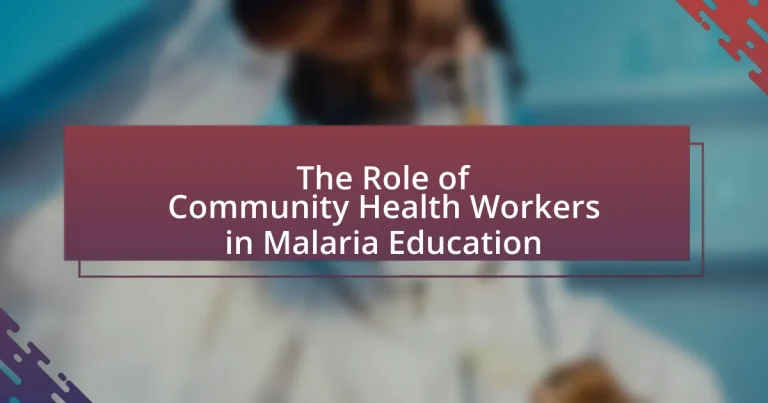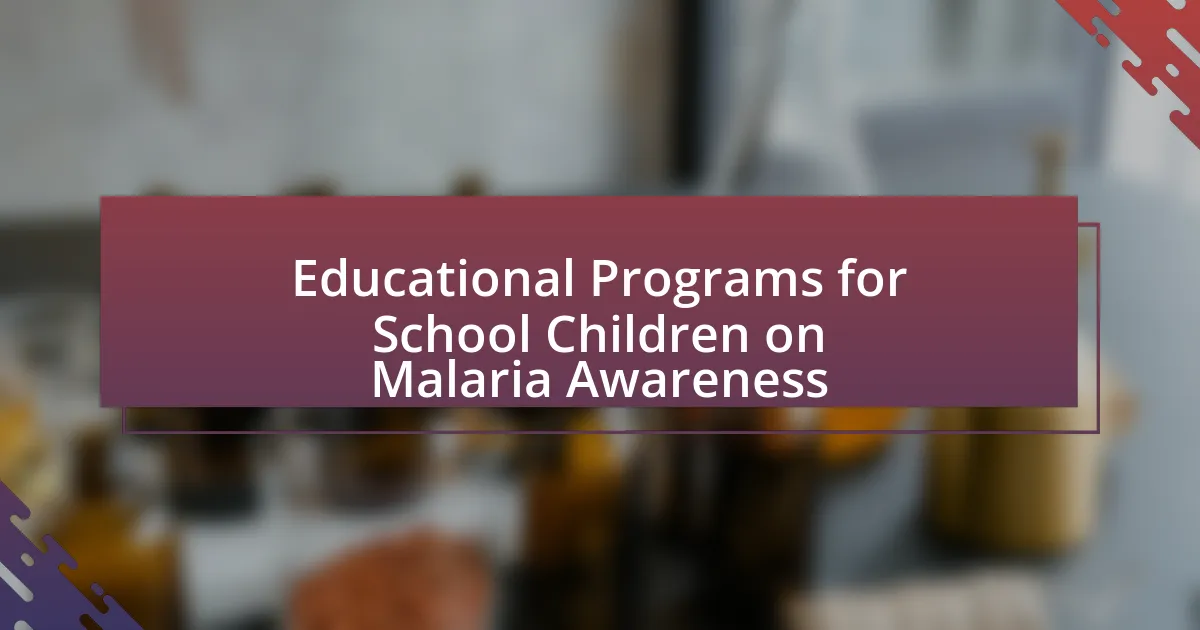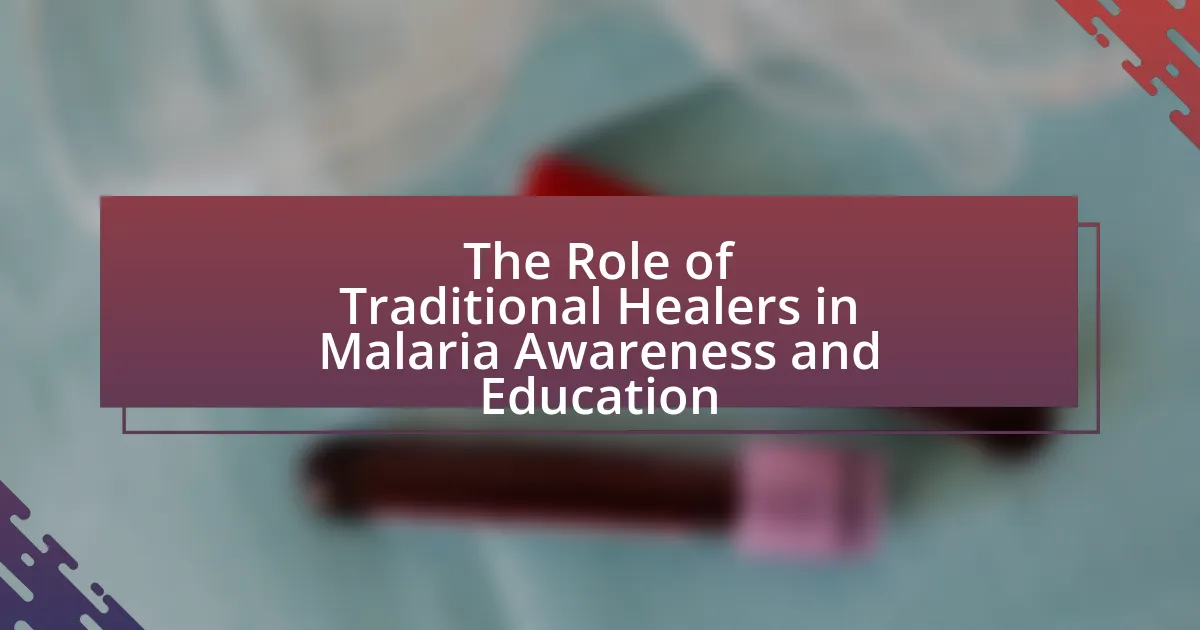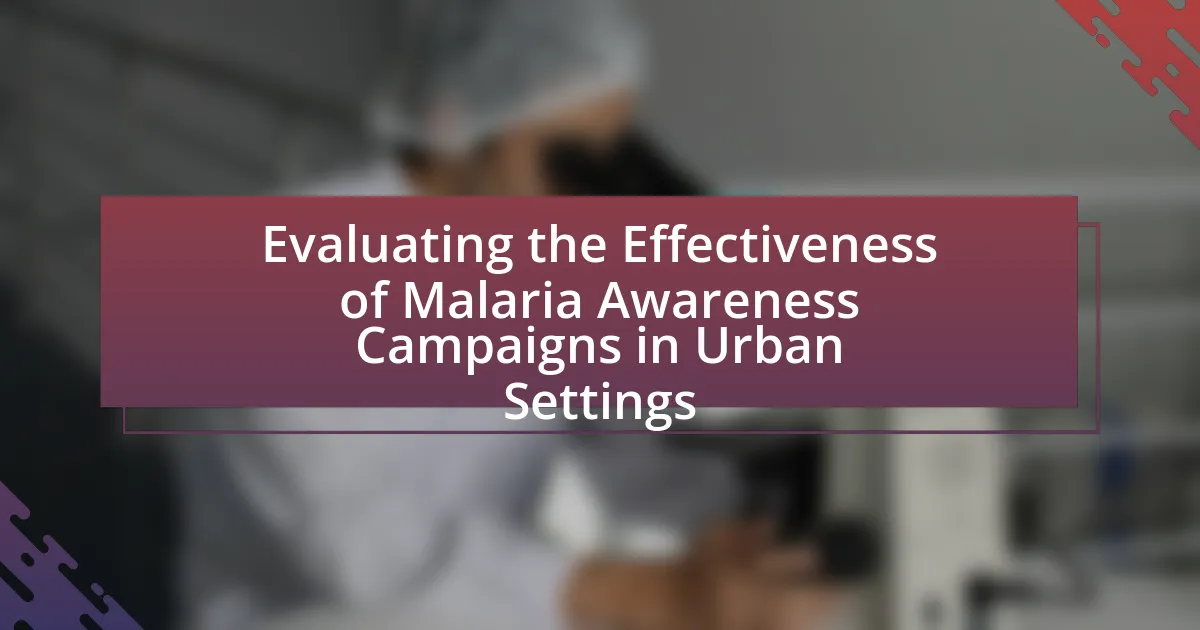Community Health Workers (CHWs) are essential in malaria education, acting as local resources for information and support. They enhance community awareness about malaria prevention, symptoms, and treatment through outreach programs, educational materials, and personalized home visits. The article examines the specific strategies employed by CHWs, the importance of malaria education in public health, and the challenges they face, including resource limitations and cultural barriers. It also highlights best practices for improving training and community engagement, as well as the collaborative efforts needed to strengthen malaria education initiatives.
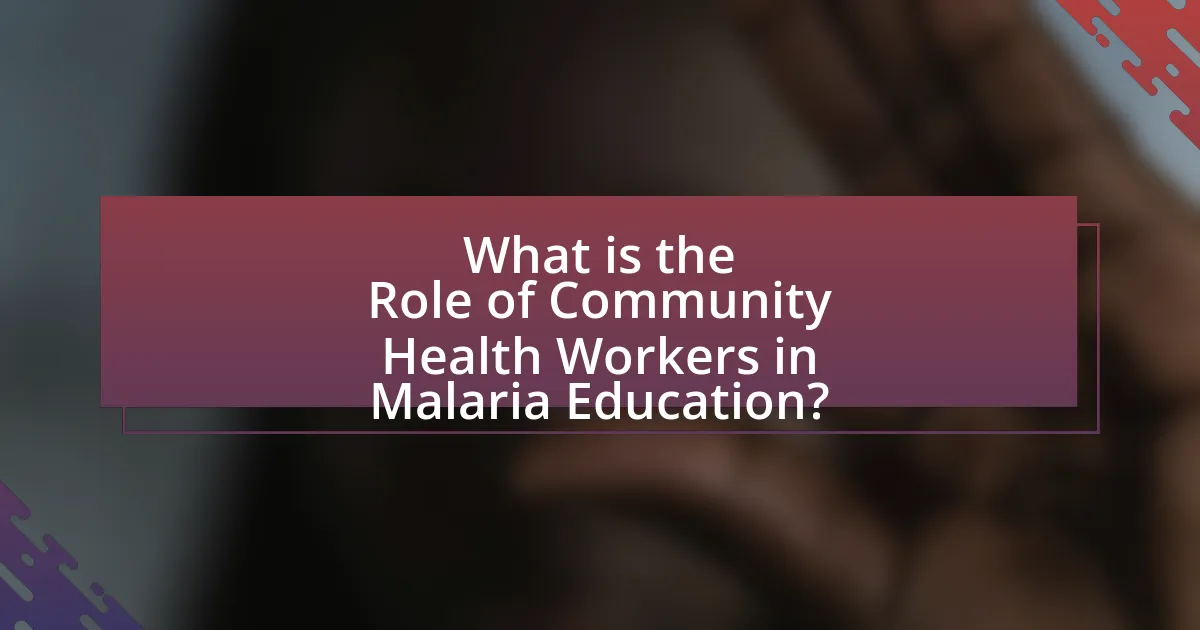
What is the Role of Community Health Workers in Malaria Education?
Community Health Workers (CHWs) play a crucial role in malaria education by serving as trusted local resources for information and support. They educate communities about malaria prevention, symptoms, and treatment options, thereby increasing awareness and understanding of the disease. CHWs often conduct outreach programs, distribute educational materials, and facilitate access to healthcare services, which has been shown to improve malaria knowledge and reduce incidence rates. For instance, a study published in the American Journal of Tropical Medicine and Hygiene found that communities with active CHW programs experienced a significant decrease in malaria cases due to enhanced education and preventive measures.
How do Community Health Workers contribute to malaria education?
Community Health Workers (CHWs) contribute to malaria education by providing essential information and resources to local communities, thereby increasing awareness and understanding of malaria prevention and treatment. They engage in direct outreach, conducting educational sessions that cover topics such as the life cycle of the malaria parasite, symptoms of the disease, and the importance of using insecticide-treated bed nets. Research indicates that CHWs significantly improve knowledge about malaria, as evidenced by a study published in the American Journal of Tropical Medicine and Hygiene, which found that communities served by CHWs had a 30% higher understanding of malaria prevention strategies compared to those without CHW involvement. This direct engagement fosters community empowerment and encourages individuals to take proactive measures against malaria, ultimately reducing transmission rates.
What specific educational strategies do they employ?
Community health workers employ several specific educational strategies to enhance malaria education. These strategies include community engagement through participatory learning, where health workers involve community members in discussions and activities related to malaria prevention and treatment. They also utilize culturally relevant materials and methods, such as visual aids and local languages, to ensure comprehension and retention of information. Additionally, they conduct home visits to provide personalized education and support, which has been shown to increase knowledge and behavior change regarding malaria prevention. Evidence from studies indicates that these strategies significantly improve community awareness and reduce malaria incidence, demonstrating their effectiveness in public health education.
How do they engage with the community to raise awareness?
Community health workers engage with the community to raise awareness about malaria through educational outreach programs, workshops, and home visits. These initiatives provide vital information on malaria prevention, symptoms, and treatment options, directly addressing community needs. For instance, studies have shown that community health workers can significantly increase knowledge and awareness of malaria, leading to improved health-seeking behaviors and reduced incidence rates.
Why is malaria education important in community health?
Malaria education is crucial in community health because it empowers individuals with knowledge to prevent and control the disease. Educated communities can recognize symptoms, understand transmission methods, and adopt preventive measures such as using insecticide-treated nets and seeking timely medical care. According to the World Health Organization, effective malaria education can reduce transmission rates and improve treatment outcomes, ultimately leading to lower morbidity and mortality associated with the disease.
What are the impacts of malaria on public health?
Malaria significantly impacts public health by causing high morbidity and mortality rates, particularly in endemic regions. According to the World Health Organization, there were an estimated 241 million cases of malaria worldwide in 2020, resulting in approximately 627,000 deaths, predominantly among children under five years old. This disease strains healthcare systems, leading to increased healthcare costs and loss of productivity due to illness. Additionally, malaria contributes to the cycle of poverty, as affected individuals and families face economic hardships due to medical expenses and loss of income. The burden of malaria also hinders educational attainment, as children suffering from the disease may miss school, further perpetuating the cycle of disadvantage.
How does education influence malaria prevention and control?
Education significantly influences malaria prevention and control by enhancing knowledge and awareness about the disease, its transmission, and preventive measures. When communities are educated about malaria, individuals are more likely to adopt protective behaviors, such as using insecticide-treated bed nets and seeking timely medical treatment. Studies have shown that educational interventions can lead to a substantial increase in the use of preventive measures; for instance, a systematic review indicated that community-based education programs improved bed net usage by up to 50% in some regions. Furthermore, education empowers community health workers to disseminate accurate information, thereby fostering a culture of prevention and control that can reduce malaria incidence and mortality rates.
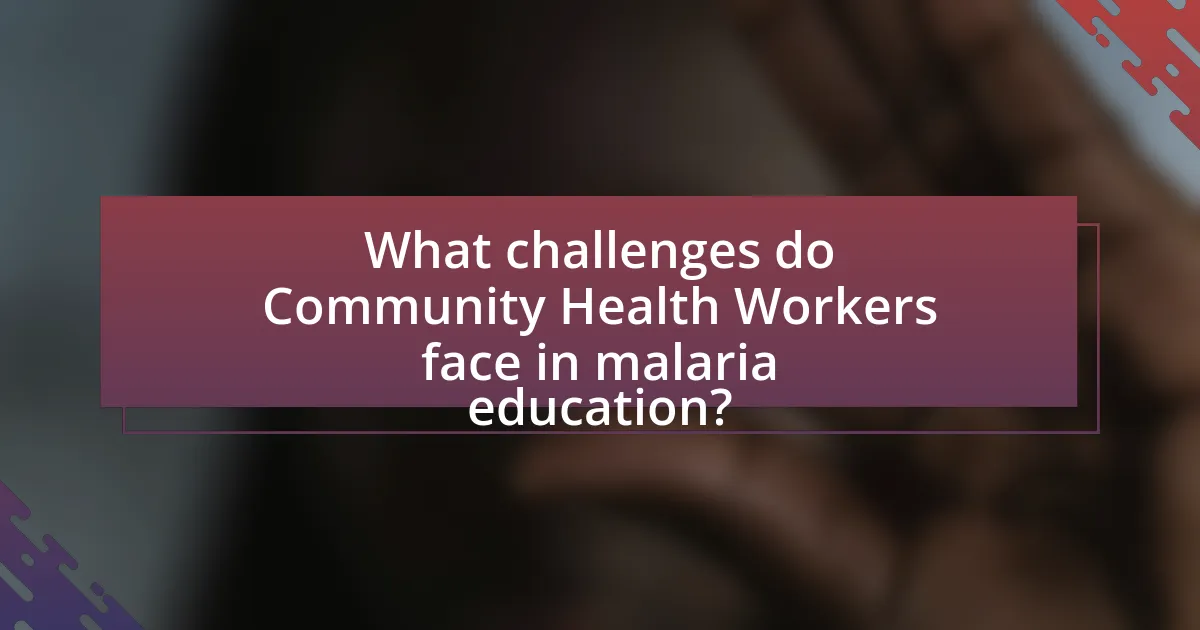
What challenges do Community Health Workers face in malaria education?
Community Health Workers face several challenges in malaria education, including limited resources, lack of training, and cultural barriers. Limited resources hinder their ability to provide comprehensive education and access to preventive measures, such as insecticide-treated nets and antimalarial medications. A study published in the American Journal of Tropical Medicine and Hygiene highlights that inadequate training leads to gaps in knowledge about malaria transmission and prevention, which affects the quality of information they can share with communities. Additionally, cultural barriers, such as local beliefs and practices regarding health, can impede effective communication and acceptance of malaria education initiatives. These challenges collectively impact the effectiveness of Community Health Workers in combating malaria through education.
How do resource limitations affect their effectiveness?
Resource limitations significantly reduce the effectiveness of community health workers in malaria education. When resources such as funding, training, and materials are scarce, community health workers struggle to deliver comprehensive education and preventive measures to the communities they serve. For instance, a study published in the “American Journal of Tropical Medicine and Hygiene” found that inadequate training and lack of educational materials directly correlated with lower community engagement and understanding of malaria prevention strategies. This limitation hampers their ability to conduct outreach, provide accurate information, and implement effective interventions, ultimately leading to higher malaria incidence rates in affected areas.
What types of resources are most critical for their work?
Community health workers in malaria education critically rely on educational materials, training programs, and community engagement resources. Educational materials, such as pamphlets and visual aids, provide essential information about malaria prevention and treatment. Training programs equip these workers with the necessary skills and knowledge to effectively communicate health messages. Community engagement resources, including local partnerships and outreach initiatives, facilitate trust and collaboration with the communities they serve, enhancing the effectiveness of malaria education efforts.
How can these limitations be addressed?
Limitations in the role of community health workers in malaria education can be addressed through targeted training and resource allocation. By providing comprehensive training programs that focus on malaria prevention, treatment, and community engagement, community health workers can enhance their effectiveness. Research indicates that well-trained health workers significantly improve health outcomes; for instance, a study published in the American Journal of Tropical Medicine and Hygiene found that training community health workers led to a 30% increase in malaria knowledge among community members. Additionally, ensuring adequate resources, such as educational materials and access to diagnostic tools, empowers community health workers to deliver accurate information and services. This dual approach of training and resource provision effectively mitigates the limitations faced in malaria education initiatives.
What barriers exist in community engagement for malaria education?
Barriers in community engagement for malaria education include lack of awareness, cultural beliefs, and limited access to resources. Lack of awareness often results from insufficient outreach efforts, leading to communities not understanding the importance of malaria prevention and treatment. Cultural beliefs can hinder acceptance of health messages, as traditional practices may conflict with modern medical advice. Limited access to resources, such as educational materials and trained personnel, restricts the effectiveness of community health workers in disseminating information. These barriers collectively impede the successful engagement of communities in malaria education initiatives.
How do cultural beliefs impact malaria education efforts?
Cultural beliefs significantly impact malaria education efforts by influencing community perceptions and behaviors regarding the disease. For instance, in some cultures, traditional beliefs may attribute malaria to spiritual causes rather than biological ones, leading to reliance on traditional healers instead of seeking medical treatment. A study published in the “American Journal of Tropical Medicine and Hygiene” by K. A. K. K. et al. (2020) found that communities with strong traditional beliefs about illness were less likely to accept modern malaria interventions, such as insecticide-treated nets and antimalarial medications. This disconnect can hinder effective education and prevention strategies, as community health workers may struggle to convey the importance of scientifically-based malaria prevention methods when faced with deeply rooted cultural beliefs.
What strategies can overcome these barriers?
Community health workers can overcome barriers to malaria education through targeted training, community engagement, and the use of technology. Targeted training equips health workers with the necessary knowledge and skills to effectively communicate malaria prevention and treatment methods. For instance, a study published in the American Journal of Tropical Medicine and Hygiene found that training community health workers significantly improved their ability to educate the community about malaria symptoms and prevention strategies.
Community engagement fosters trust and encourages participation, as health workers collaborate with local leaders to tailor educational messages to cultural contexts. Research from the World Health Organization indicates that community involvement in health education leads to higher acceptance and adherence to malaria prevention practices.
Additionally, leveraging technology, such as mobile health applications, can enhance information dissemination and facilitate real-time communication between health workers and the community. A study in the Journal of Medical Internet Research demonstrated that mobile health interventions increased knowledge and awareness of malaria among community members. These strategies collectively address barriers by improving knowledge, fostering trust, and utilizing innovative communication methods.
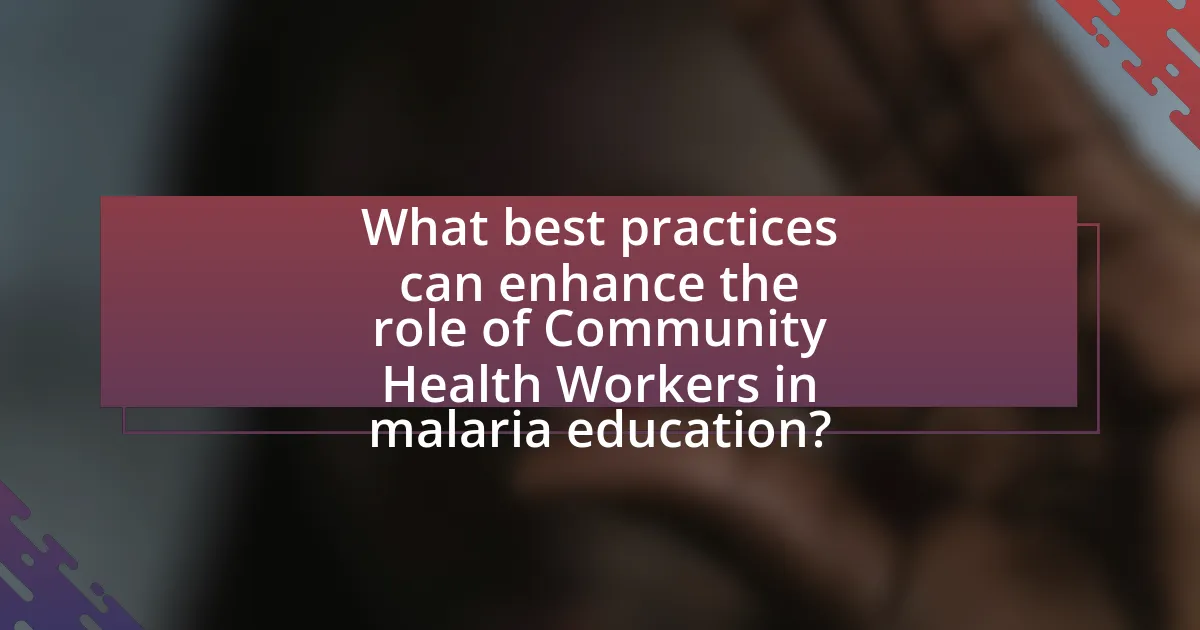
What best practices can enhance the role of Community Health Workers in malaria education?
Best practices that can enhance the role of Community Health Workers (CHWs) in malaria education include comprehensive training, community engagement, and the use of culturally relevant materials. Comprehensive training equips CHWs with the necessary knowledge about malaria transmission, prevention, and treatment, which is essential for effective education. For instance, a study published in the American Journal of Tropical Medicine and Hygiene found that well-trained CHWs significantly improved community awareness and practices regarding malaria prevention.
Community engagement fosters trust and encourages participation, allowing CHWs to tailor their educational efforts to the specific needs and beliefs of the community. Research from the World Health Organization indicates that community involvement in health education leads to better health outcomes. Additionally, using culturally relevant materials ensures that the information resonates with the community, making it more likely that individuals will adopt recommended practices. This approach has been shown to enhance understanding and retention of information, as evidenced by various health education programs that successfully reduced malaria incidence in targeted populations.
How can training programs be improved for Community Health Workers?
Training programs for Community Health Workers can be improved by incorporating evidence-based practices, enhancing curriculum relevance, and providing ongoing support. Evidence-based practices ensure that training is grounded in the latest research, which has been shown to increase the effectiveness of health interventions. For instance, a study published in the Journal of Global Health found that training programs that utilized evidence-based guidelines resulted in a 30% increase in the knowledge and skills of Community Health Workers.
Enhancing curriculum relevance involves tailoring training content to the specific health challenges faced in the communities they serve, such as malaria education. This targeted approach has been supported by research from the World Health Organization, which emphasizes the importance of context-specific training to improve health outcomes.
Finally, providing ongoing support through mentorship and refresher courses helps maintain the skills and knowledge of Community Health Workers over time. A systematic review in the BMC Health Services Research highlighted that continuous professional development significantly improves the performance of health workers in community settings.
What key topics should be included in training?
Key topics that should be included in training for Community Health Workers in Malaria Education are malaria transmission, prevention strategies, treatment protocols, community engagement techniques, and data collection methods. Understanding malaria transmission is crucial, as it informs prevention strategies such as the use of insecticide-treated nets and indoor residual spraying. Familiarity with treatment protocols ensures that health workers can provide accurate information on antimalarial medications. Community engagement techniques are essential for effectively communicating with and educating the community about malaria risks and prevention. Lastly, data collection methods are important for monitoring malaria cases and evaluating the effectiveness of educational interventions. These topics are supported by the World Health Organization’s guidelines on malaria prevention and control, which emphasize the importance of comprehensive training for health workers in endemic regions.
How can ongoing support be provided to these workers?
Ongoing support for community health workers in malaria education can be provided through regular training sessions and access to updated resources. Continuous education ensures that these workers remain informed about the latest malaria prevention strategies and treatment protocols, which is crucial for effective community outreach. For instance, organizations like the World Health Organization emphasize the importance of ongoing training to adapt to evolving health challenges, thereby enhancing the workers’ capabilities and confidence in their roles. Additionally, establishing a mentorship system can facilitate knowledge sharing and provide emotional support, further strengthening the workforce dedicated to malaria education.
What collaborative efforts can strengthen malaria education initiatives?
Collaborative efforts that can strengthen malaria education initiatives include partnerships between community health workers, local governments, non-governmental organizations, and educational institutions. These collaborations enhance resource sharing, increase outreach, and improve the effectiveness of educational programs. For instance, a study published in the American Journal of Tropical Medicine and Hygiene highlights that community health workers, when supported by local health authorities and NGOs, can significantly increase awareness and knowledge about malaria prevention and treatment in rural areas. This synergy allows for tailored educational materials and culturally relevant messaging, which are crucial for effective communication in malaria education.
How can partnerships with local organizations enhance outreach?
Partnerships with local organizations enhance outreach by leveraging established community trust and networks. Local organizations often have deep-rooted connections within the community, which can facilitate more effective communication and engagement with residents. For instance, a study published in the American Journal of Public Health found that community-based interventions, when supported by local organizations, increased participation rates in health programs by up to 50%. This demonstrates that collaboration with local entities not only broadens the reach of health initiatives but also fosters a sense of ownership and relevance among community members, ultimately leading to improved health outcomes.
What role do government and NGOs play in supporting these efforts?
Governments and NGOs play a crucial role in supporting community health workers in malaria education by providing funding, resources, and training. Governments often allocate budgets for malaria prevention and control programs, which include training community health workers to educate the public about malaria transmission and prevention methods. For instance, the World Health Organization reported that countries with strong government support for malaria initiatives saw a significant reduction in malaria cases. NGOs complement these efforts by implementing community-based programs, conducting awareness campaigns, and facilitating access to diagnostic tools and treatment. A study published in the Lancet highlighted that NGO-led initiatives increased community engagement and improved health outcomes in malaria-endemic regions.
What practical tips can Community Health Workers use to improve malaria education?
Community Health Workers can improve malaria education by utilizing community engagement strategies, such as organizing local workshops and informational sessions. These sessions can effectively disseminate knowledge about malaria prevention, symptoms, and treatment options. Research indicates that community-based education significantly increases awareness and understanding of malaria, leading to higher rates of preventive measures, such as the use of insecticide-treated nets. Additionally, Community Health Workers should leverage local leaders and influencers to enhance credibility and reach within the community, as studies show that peer-led initiatives can improve health education outcomes.
